Behind The Lens: The ‘Lumendorff’ A. Lange & Söhne Datograph Lumen With Unique Custom-Fitted Platinum Bracelet
by GaryG
A couple of years ago, I had the pleasure of writing about one collector’s obsession with the A. Lange & Söhne Datograph Lumen and the platinum Lange bracelet made by Wellendorff, and his journey to combine the two by commissioning the creation of custom-fit end links in platinum to match the bracelet to the dimensions of the Lumen’s case and the drilling of its lugs.
At the time, I hadn’t had the opportunity to handle the watch and relied on photos taken by its proud owner. More recently, the piece made its way to California, and through the generosity of a good friend I was able to see, photograph, and wear this remarkable timepiece.
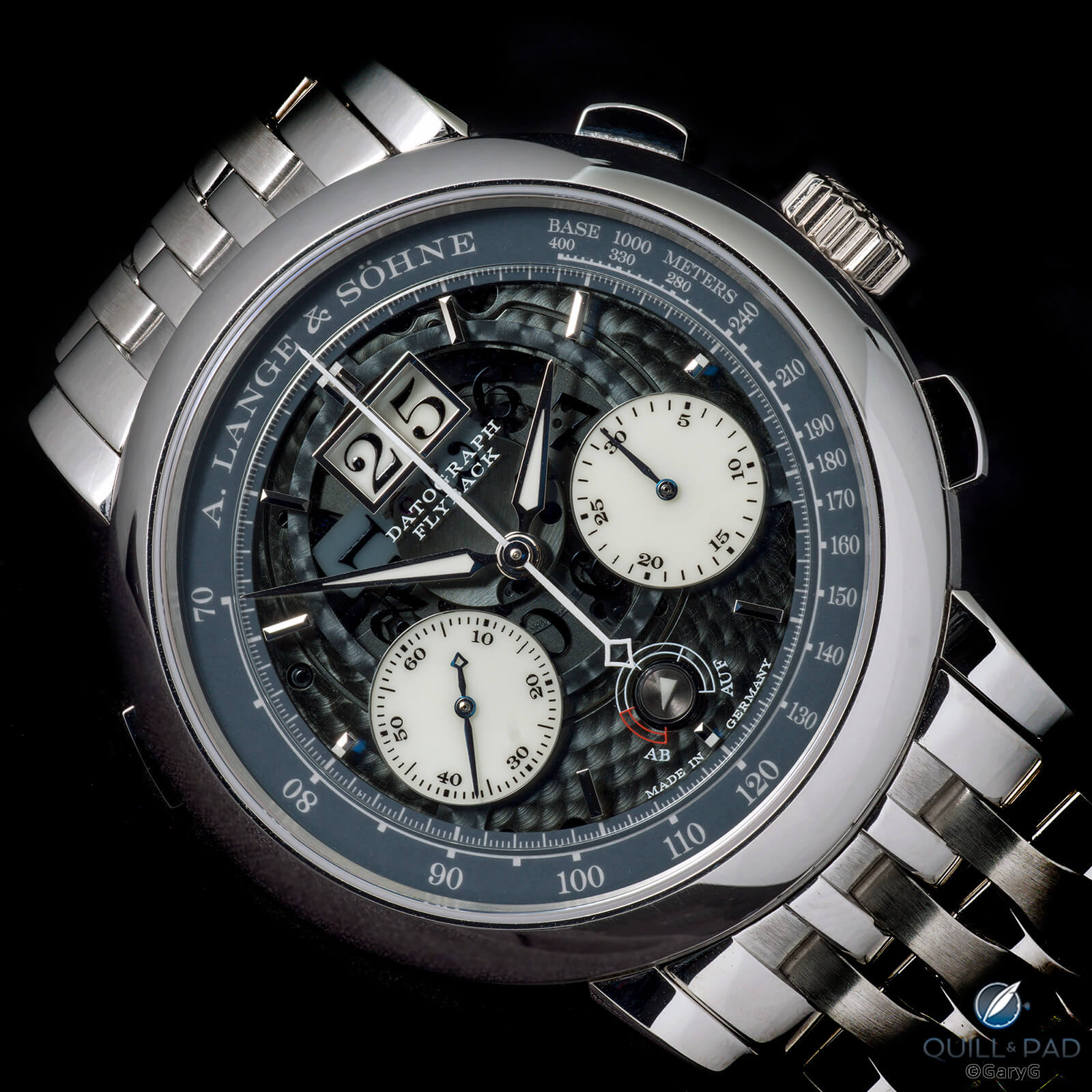
A. Lange & Söhne Datograph Lumen with custom-fitted platinum bracelet
Since this is a “Behind the Lens” article there will obviously be more photos, but this first image already tells us a great deal about the watch. In particular, I was drawn to the exposed workings of the date mechanism, with a luminous cross for the tens and clear ring with printed numerals for the ones, each awaiting its turn to pop into place in front of a fixed luminous rectangle located behind the ones box in the big date display.
There’s also the prominent perlage on the interior plates to enjoy and the different luminous finishes on hands, subsidiary displays, and tachymeter chapter ring that all come into play in the dark. And of course, we can see the custom-made end links hugging the contour of the 41 mm diameter case and leading into the “wavy gravy” design of the original Datograph bracelet.
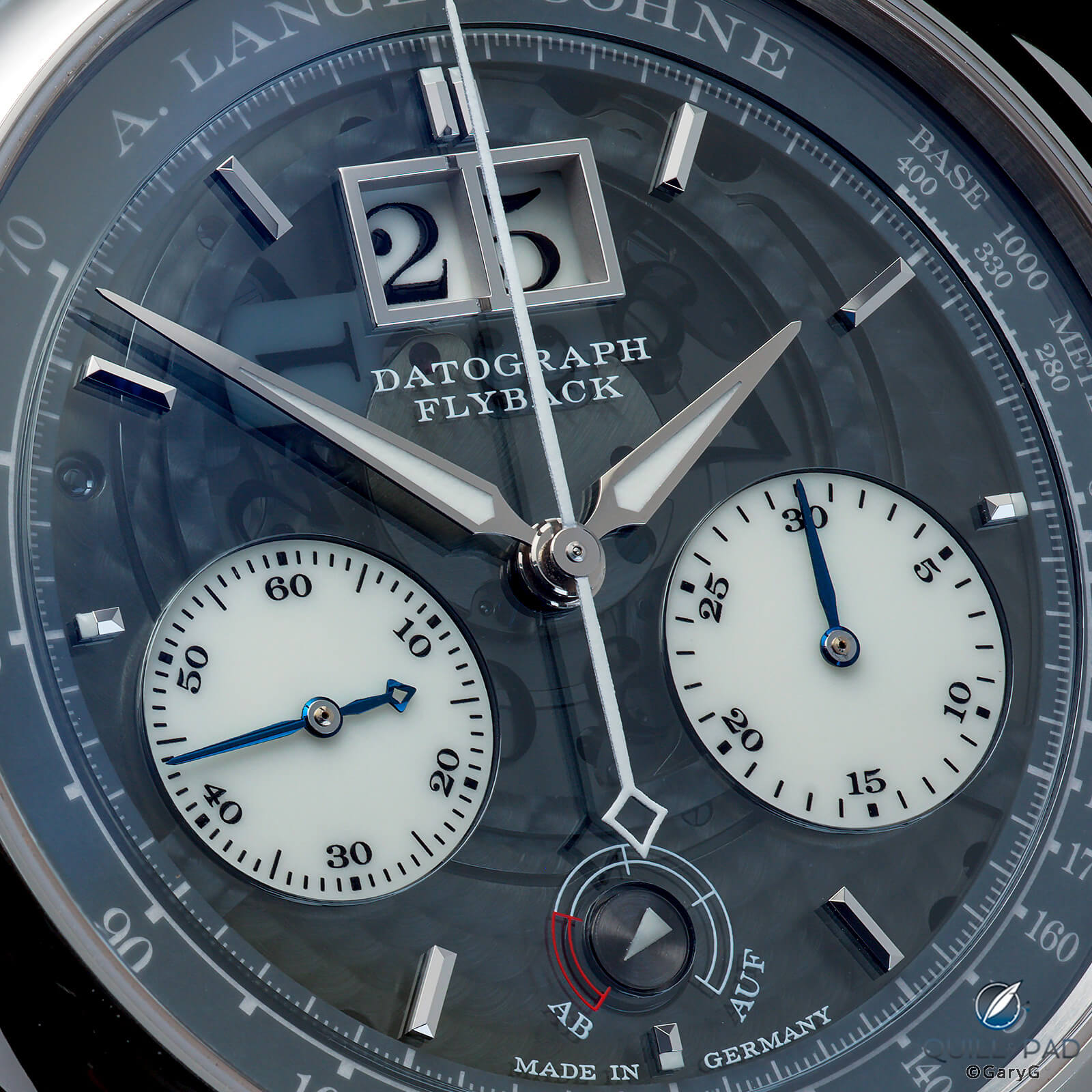
Detail view, Datograph Lumen dial
In the detail shot above, other features become prominent, including the small blued-steel hands on the subdials, the characteristic shape of the tails on the chronograph and running second hand, and the power reserve indicator with its splash of red in the depletion zone.
I’m struck by how well A. Lange & Söhne managed to retain the look of the Datograph even with the translucent dial and changes to the subdial and chapter ring surfaces. If anything, the “manhole cover” power reserve disk integrates better on this dial than on the stock Datograph Up-Down, as the joining line between disk and main dial is somewhat less evident.
Pretty much all watches change appearance somewhat under different light conditions, but with the Datograph Lumen the effect is even more pronounced. Check out the two images side by side below: same watch, same camera, same position, but with different flash positions and intensities.
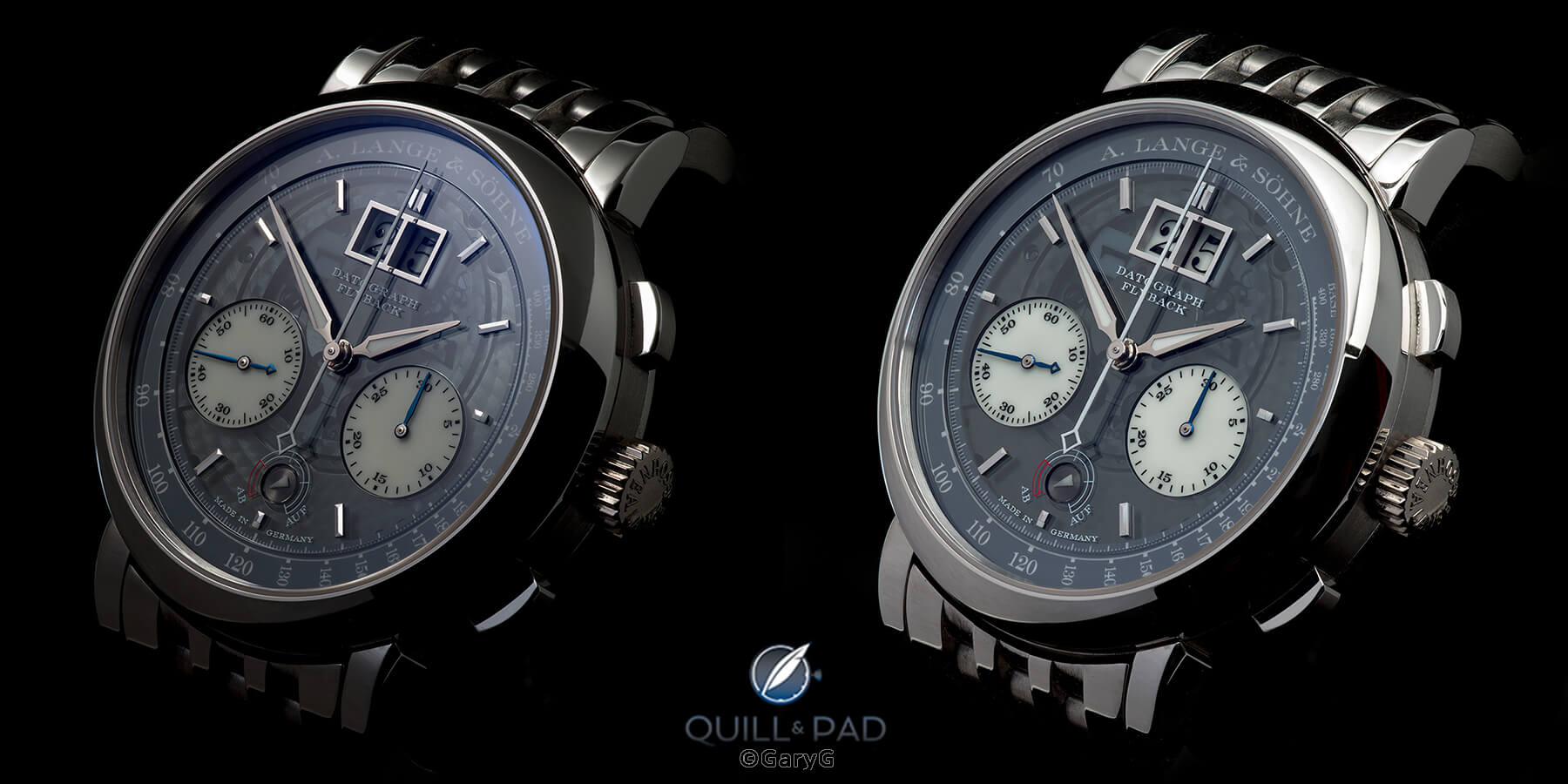
Side by side: lighting study with the Datograph Lumen from A. Lange & Söhne
Even in the moodier image on the left, the hands and indices are quite prominent, suggesting how easily you can read the time under low-light conditions with a slight angling of the wrist. Also, on the left we get a hint of the greenish lume on the subdials, and the oblique light makes the convex forms of the printed numerals and logo evident.
In the higher-key look on the right, the lume appears whiter, the contrast between the chapter ring and main dial is clearer, and the interior of the movement – for instance, the perlage – is less visible.
If you’re getting started with watch photography, I really encourage you to try this lighting exercise for yourself. Keep the watch and camera in the same position and see how many different looks you can get simply by moving the light source – whether it’s a flash, standing light, or even a flashlight – into different positions, to a variety of distances, and using direct light as well as light filtered through a tent or a piece or two of regular printer paper.
The lume in the Lumen
I have a lot of respect for photographers who have mastered the art of the lume shot; it’s always a treat for me to see a well-rendered image of a watch in which the lume is evident. And there’s no lack of creativity out there in showing the bright bits in everything from total darkness to nearly daylight.
My technique is a bit more primitive, but my preference for tack-sharp focus translates into this realm as well.
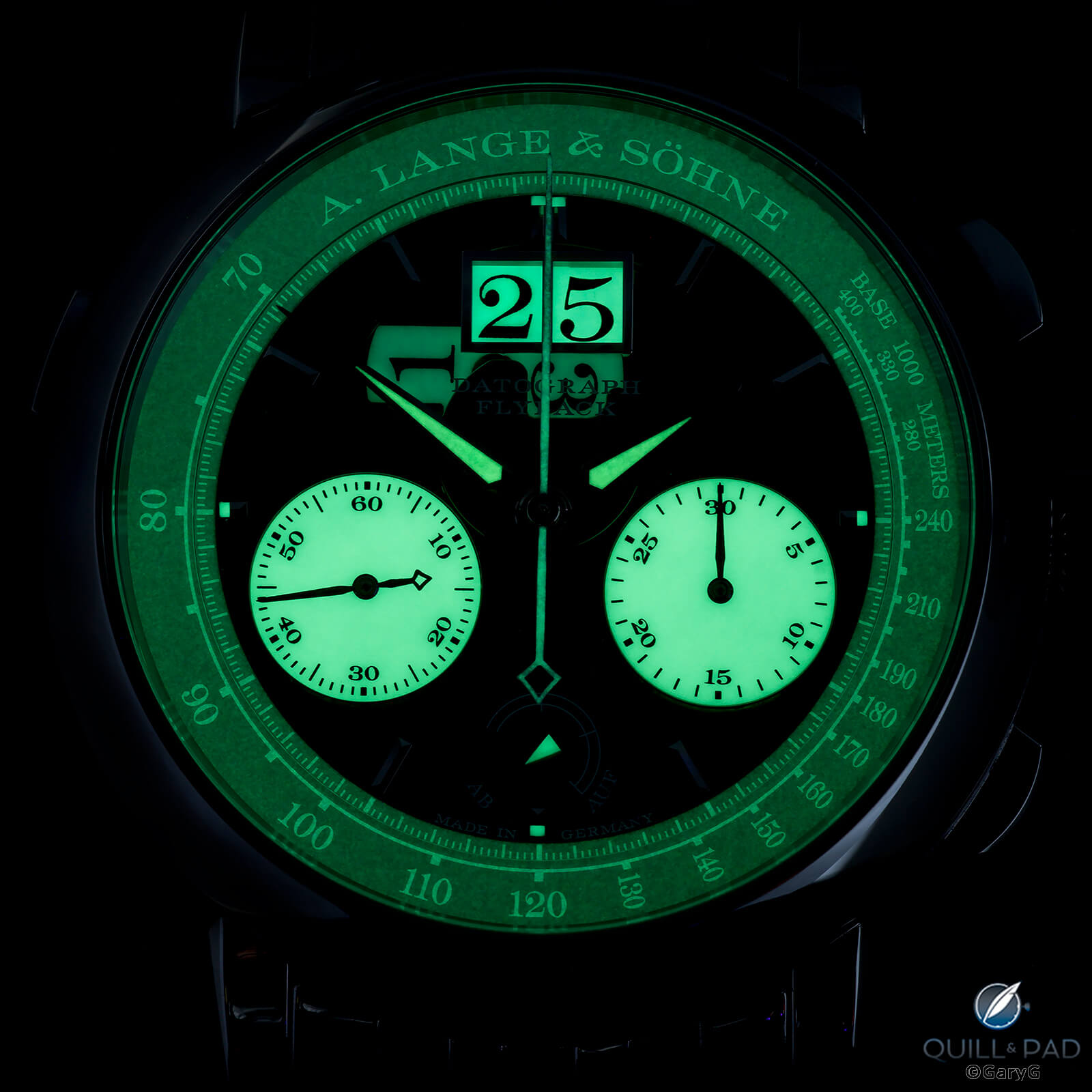
Out of the darkness: Datograph Lumen by A. Lange & Söhne
Getting the focus exactly right in a lume shot can be – quite literally – a shot in the dark; what I’ve done to create the image above is to use a focus stack of five source images, each in a slightly different focal plane that uses software to pick out the sharpest area from each image. Stacking software likes source images of similar brightness, so it took a few tries waving my UV flashlight around prior to each shutter release to get a usable stack!
Technique aside, this photo shows how A. Lange & Söhne uses different applications of luminous material on the hands, subdials, and big date elements to give us a show of green light. I’ll confess that I’d prefer a more uniform appearance of the luminous parts; and if you look very carefully, you can see that the brightness of the backgrounds of the 2 and 5 on the big date are slightly different because of the placement of the luminous layers for each, even after I cheated a bit by brightening the area behind the 2 in Photoshop.
About that bracelet
A big part of the story of this particular watch, of course, is the bracelet – an original Wellendorff creation modified to fit the Datograph Lumen case.
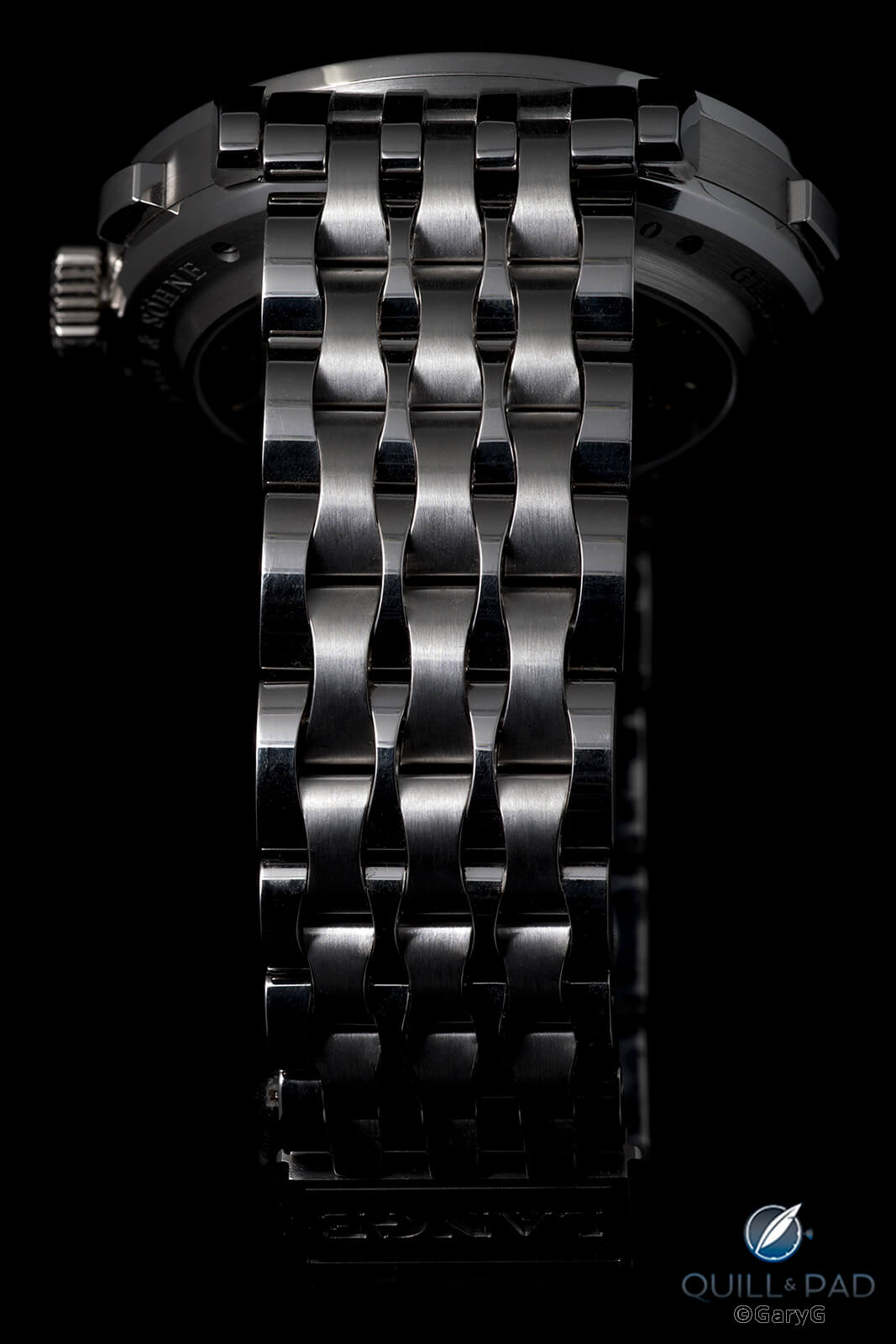
Customized wavy link bracelet, A. Lange & Söhne Datograph Lumen
A Lange & Söhne precious metal bracelets are pretty much a cult item: you either love them or hate them. I’m in the former camp, and I especially appreciate the varying link patterns that Lange commissioned to match various watches, with the undulating links on this watch being perhaps my favorite. At the owner’s request, I flipped the clasp and moved a link from one side of the bracelet to the other, and the process gave me an even greater appreciation for the bracelet’s design as I threaded the interlocking pieces together like a jigsaw puzzle.
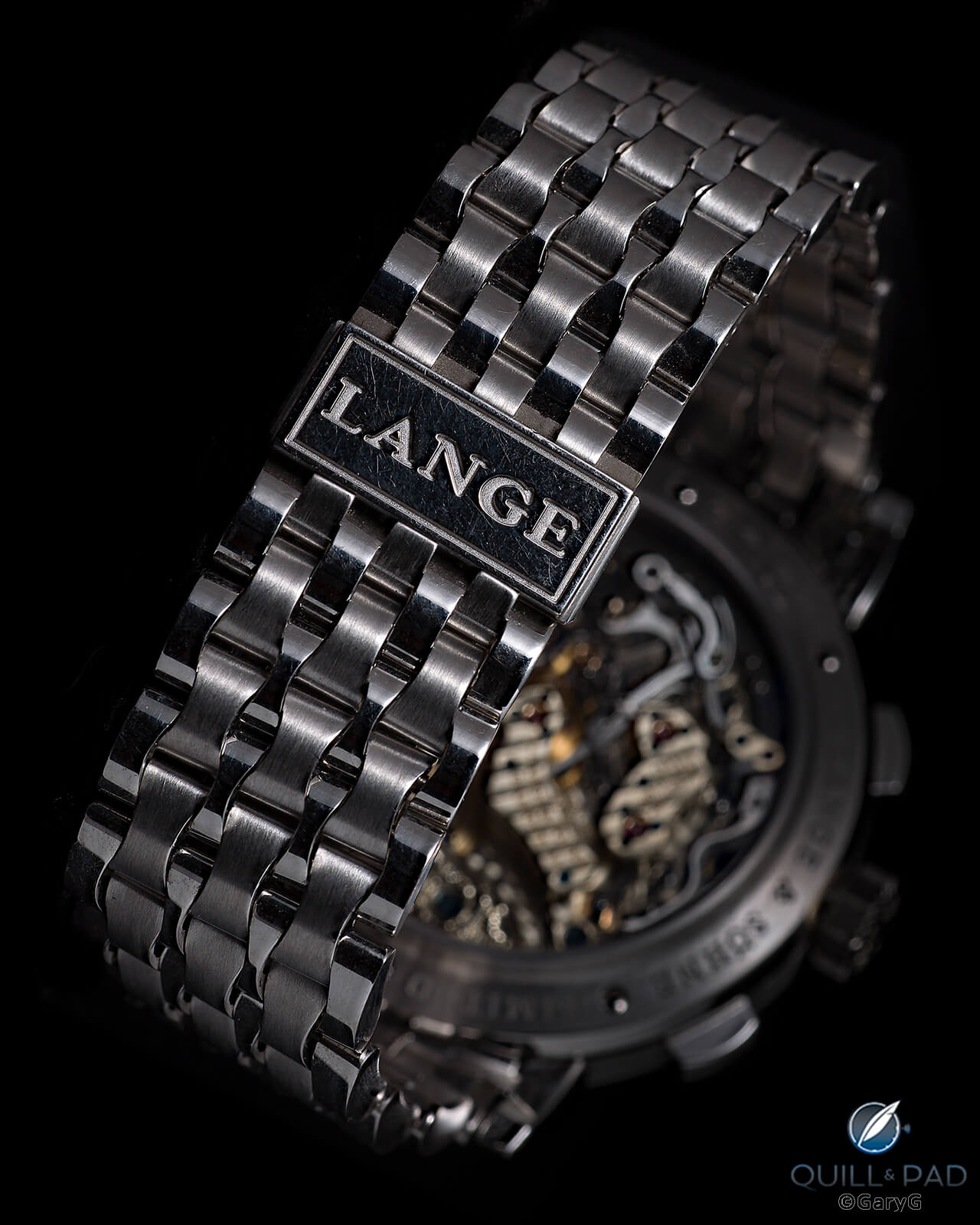
Rear view, A. Lange & Söhne platinum bracelet by Wellendorff
As seen from behind, the design is extremely clean, with the recurring pattern of the links intact on both sides until it vanishes into the simple rectangular nameplate at the center of the clasp.
Behind it all is the wonderful view that is the A. Lange & Söhne Datograph movement. On this example the German silver bridges and plates have begun to acquire a lovely patina; and for me the view of the bracelet stands up in every way to the beauty of the movement.
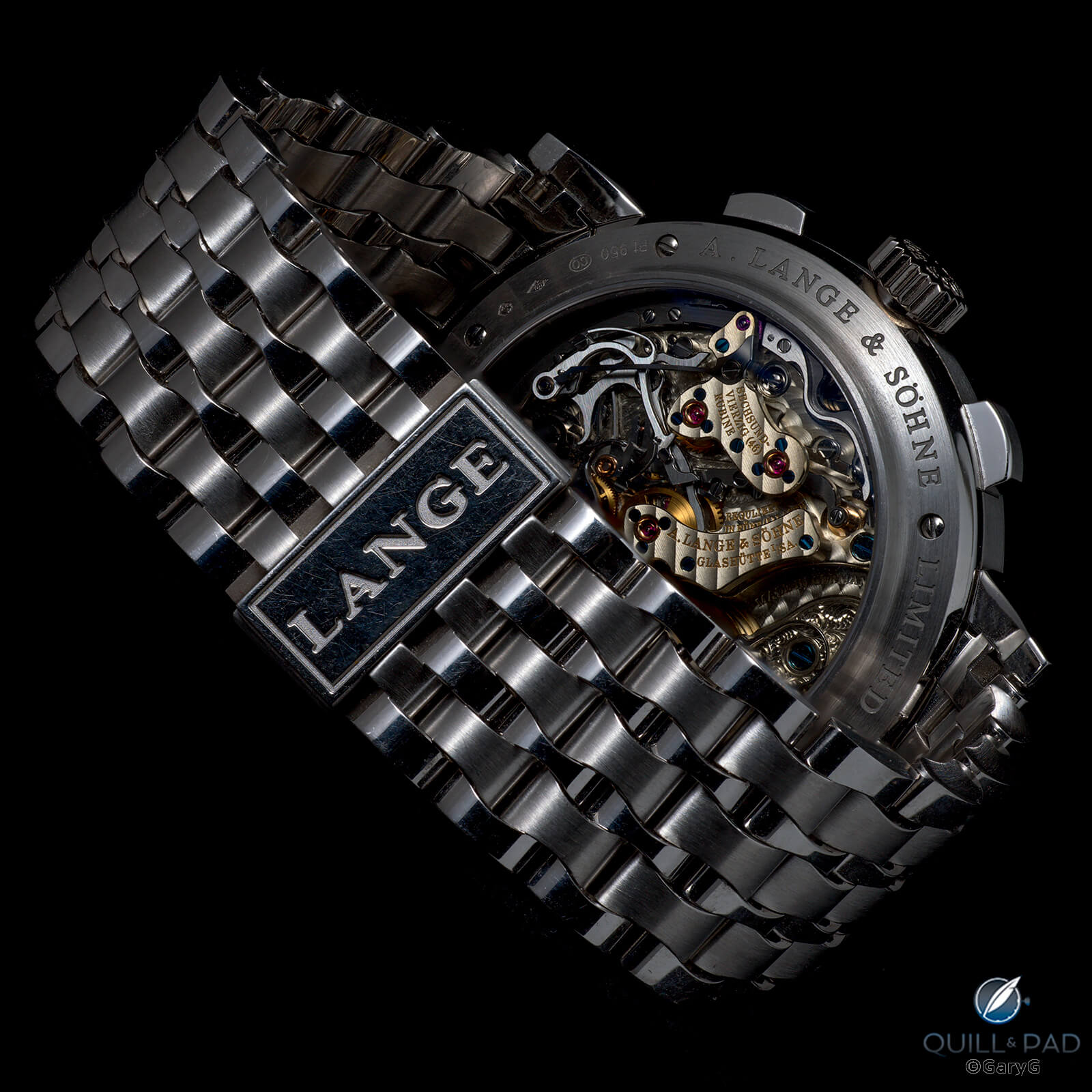
All in focus: reverse side, A. Lange & Söhne Datograph Lumen with customized bracelet
Lumendorff on the wrist
Did I sneak the watch onto my wrist before giving it back? Of course I did – at least for long enough to grab a few shots in my office and in the back garden.
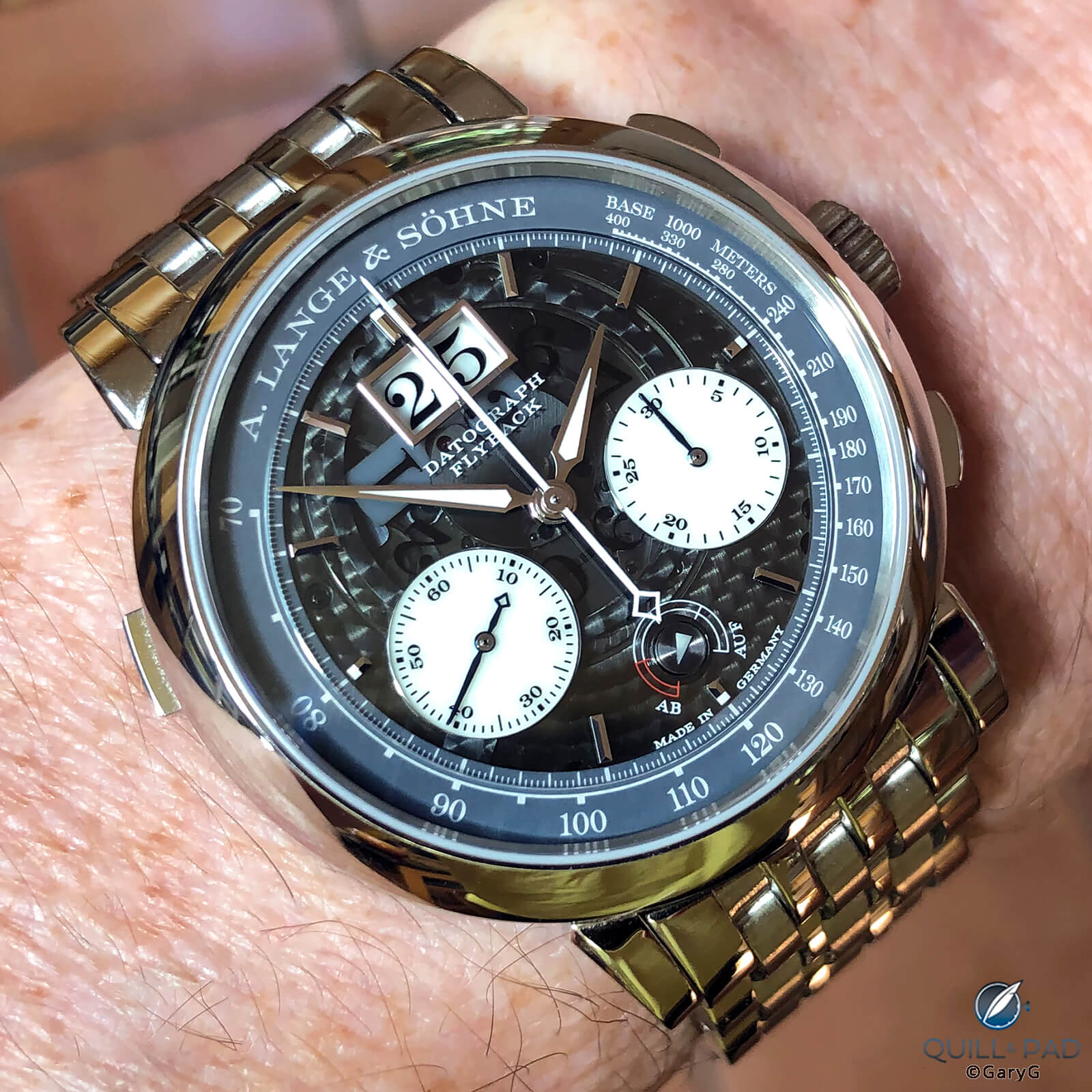
A. Lange & Söhne Datograph Lumen in direct light
I started inside, under a skylight, and captured the watch in full direct light as seen above. In daylight, the green tone of the lume isn’t evident; instead, we see on the chapter ring the characteristic grey used by A. Lange & Söhne with a more metallic dark grey in the central dial. In this shot, the stepped chapter ring is also apparent with the recessed fifth-seconds scale slightly beneath the main tachymeter.
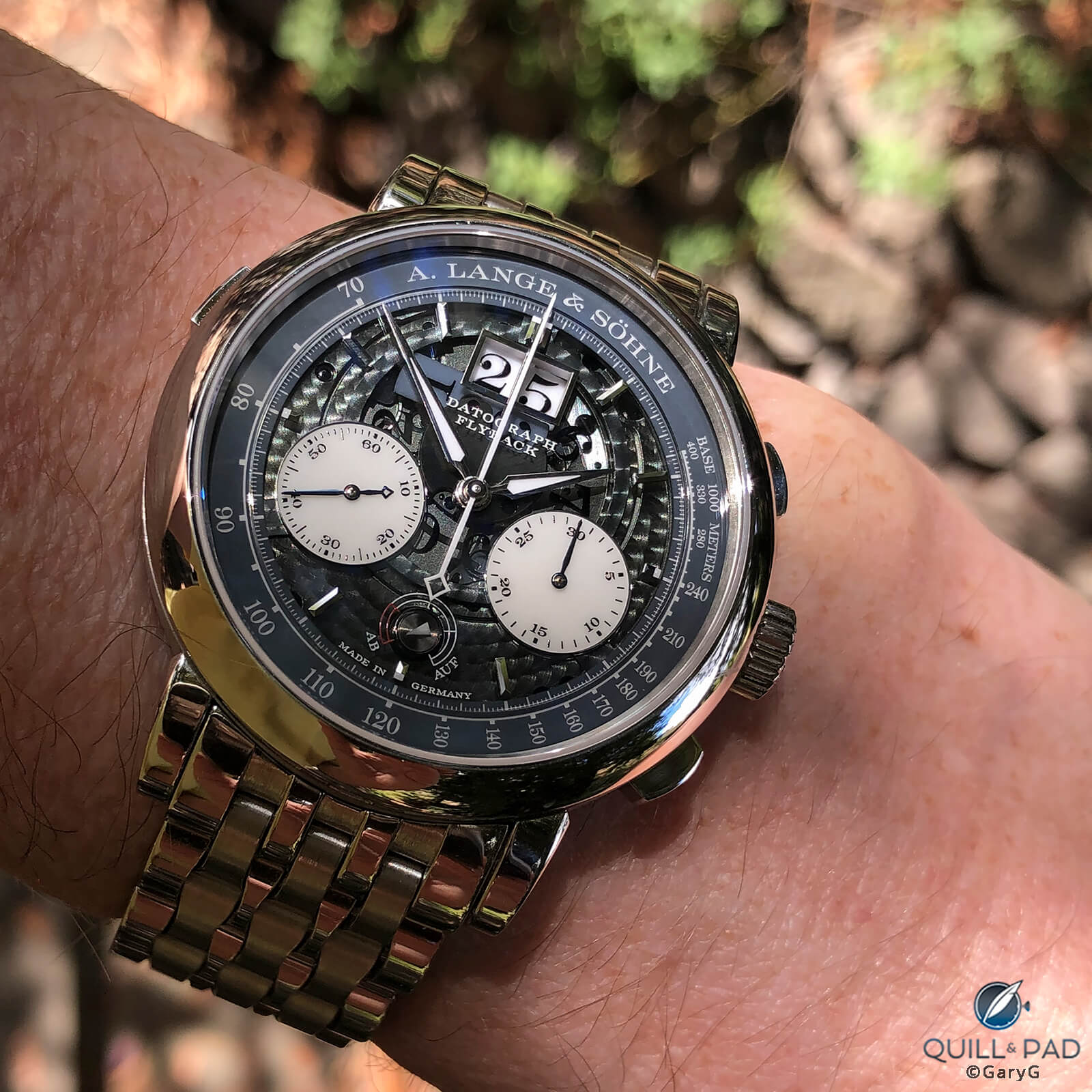
In the garden: A. Lange & Söhne Datograph Lumen in dappled sunlight
In the garden on a late summer day in California, I found some fortunate dappled light under a tree that yielded the shot above, with the interior of the watch clearly illuminated and the lower portion of the watch receding into shade. If I were fortunate enough to own this piece, I’m sure that I would spend hours going from place to place checking out the view in varying light – and enjoying every minute.
For completeness, here’s a shot of the bracelet and clasp under my wrist – as you can see, it’s fitted just a tiny bit too tight for me, otherwise I might have tried to keep the watch! I can attest that I wouldn’t want the bracelet to be too loose, as the heft of this big boy in full platinum is truly impressive.
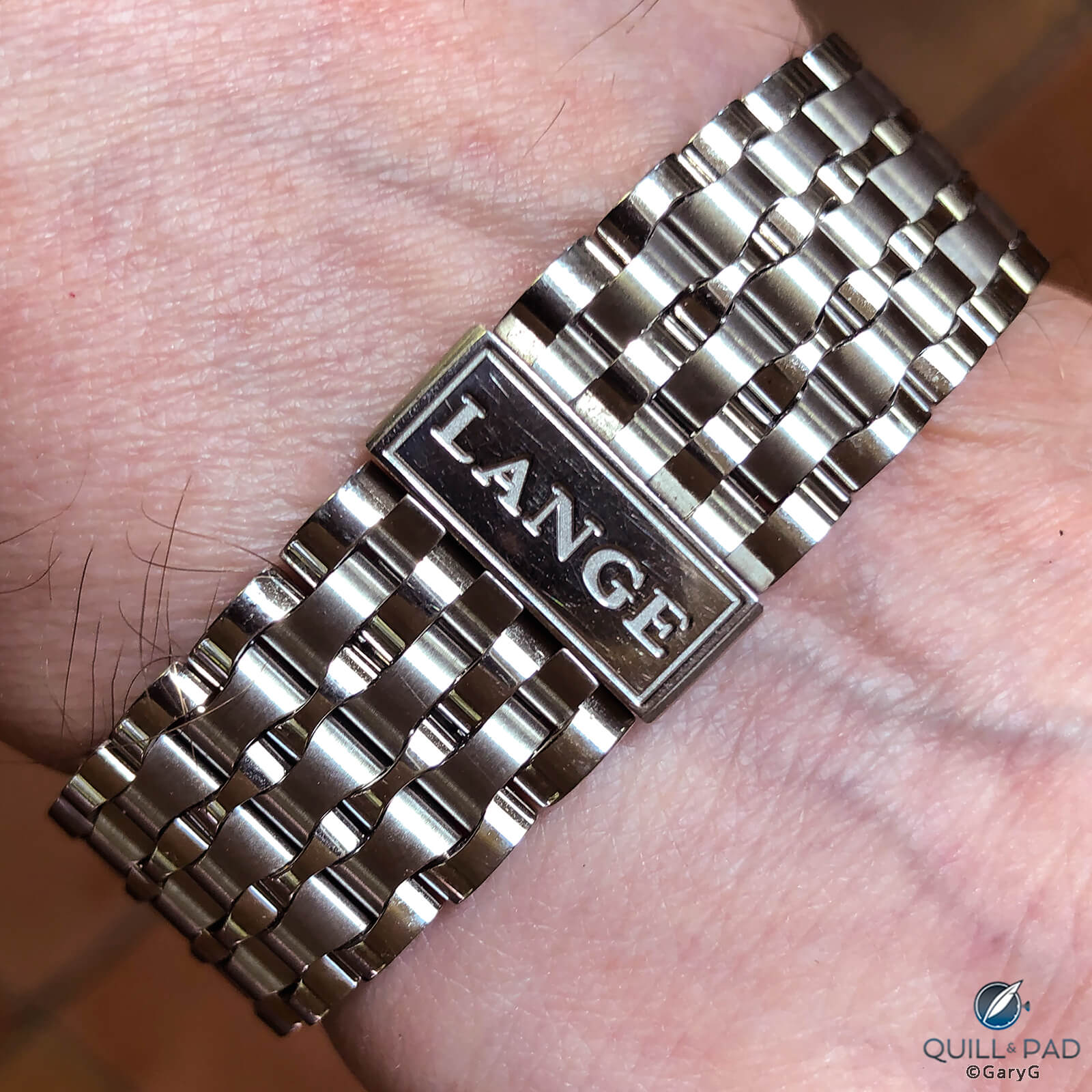
A. Lange & Söhne platinum bracelet and clasp, on the wrist
Final thoughts
The comments from readers on my original article on this watch were varied, including some suggestions that the idea of the “story watch” is getting old and that the bracelet is too ornate to be a good match for the already-busy look of the Lumen.
I get the point on storytelling with watches, at least when the stories are as banal as “here is my watch with some coffee beans.” That said, the tale behind the search for both the bracelet and watch, the disappointment of learning that the placement of the drilled spring bar holes would not allow it to be fitted, and the determination to have entirely new end links made takes the story of this particular watch to an entirely different level in my estimation; as for the visual busy-ness or lack thereof of the combination, that’s one of the differences of opinion that makes discussions in our hobby so much fun.
I’ll look forward to reading your further thoughts on this watch, and any experiences you have had with pieces that look very different depending on the light, in the comments section below. In the meantime, happy wearing – and shooting!
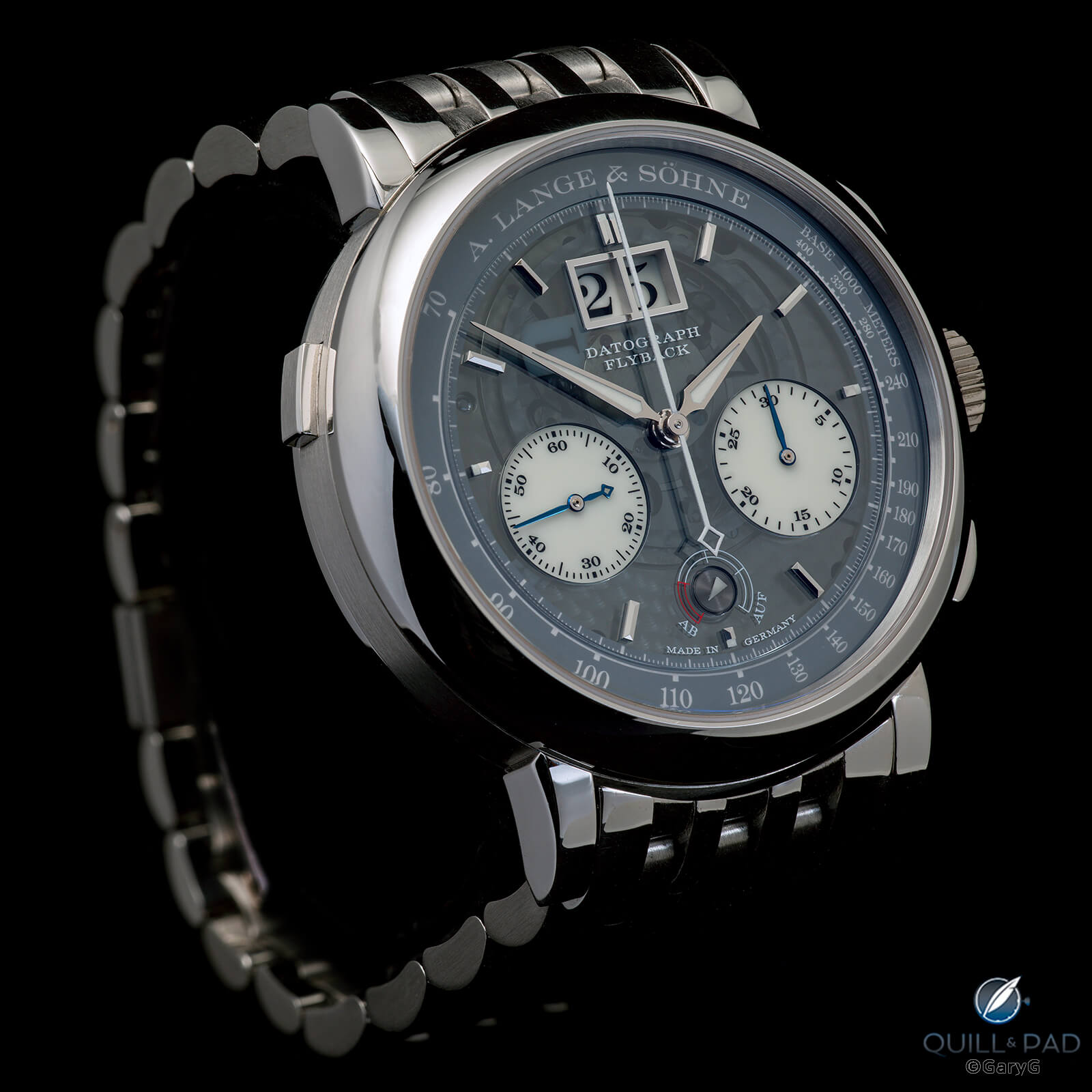
Parting shot: A. Lange & Söhne Datograph Lumen with custom-fitted platinum bracelet
Quick Facts A. Lange & Söhne Datograph Lumen Reference 405.034
Case: 41 x 13.4 mm, platinum; sapphire crystal front and rear crystals; chronograph pushers at 2 and 4; date adjustment pusher at 10
Dial and hands: German silver dial with semi-transparent sapphire crystal elements; rhodium-plated gold and blued and rhodium-plated steel hands; luminous chronograph seconds, hours, minutes, and power reserve hands; luminous tachymeter chapter ring, subdials, and big date display
Movement: manually wound Caliber L951.7; 60-hour power reserve; 18,000 vph/2.5 Hz frequency
Functions: hours, minutes, and subsidiary seconds; 30-minute flyback chronograph with instantaneously jumping minutes; power reserve; large date
Limitation: 200 watches in platinum
Price: €92,600 in Germany including VAT
Production years: 2018-now
You may also enjoy:
The Greatest Watch (Bracelet) Story Ever Told. Spoiler Alert: Lange Datograph Lumen Upgrade, What Could Possibly Go Wrong?
A. Lange & Söhne Datograph Up/Down Lumen: It’s Illuminating!
Why I Bought It: A. Lange & Söhne Datograph Perpetual
Heavy Metal: Great (And Not So Great) Watch Bracelets
Leave a Reply
Want to join the discussion?Feel free to contribute!



Dear Gary,
Thanks again for such a great article and pictures. Your lume shot stacking picture** is Really Nice.
This Datograph Lumen is a piece I really love. The story about this watch and the dedication to get shit things done is just incredible. In all honesty if it…..would be the old style case size in 39mm it would have been the puuuuurrrfect chronograph. The first execution chronograph has imho a less cluttered style dial with the absence of the up and down register. I also prefer the Roman numerals on it which give more balance. On the other hand I find the up and down dial more attractive with the luminous open-worked version than the regular MK2 up and down Datograph dial.
Now a bit more on the bracelets. A while ago I bought and sold a nos Lange 1 with a Wellendorff. With that piece I really loved the stealth wealth. The full embrace of a perfect sized watch in glowing luxury metal. A very specific precious metal since an extra dimension has been added; the specific gravity of the metal platinum. The full platinum Lange 1 even weighs twice as much as a 1665 Seadweller! The glow of the platinum is really warm and nice in the sunlight while in the artificial light it can look a bit bleak or frigid. I actually tend to love that duality since it is very much a kind of self indulgence. Because if you know, you know. Sorry non native speaker but you can understand what I mean.
Actually I know another collector who also has a non luminous regular up and down Datograph with the same Wellendorff bracelet. For sure he did not do the trick with the end links so I really don’t know how he worked it out. Will have to ask him how he figured that out and how it fits
Its also important how you match the different kind of Wellendorff bracelet with different kind of models of watches. The Datograph with this rectangular flat Wellendorrf bracelet is a perfect match. The Wellendorff with Lange 1 had a more bead of rice kind of style link bracelet with the right folding clasp. There is also a claps that is less attractive .
This particular bracelet is a great match for a Datograph. But I agree it can also be a bit busy looking with this particular bracelet combined with a luminous open worked dial. Its not a stealth looking watch at all since it pops. But the wow factor is incredible. Imho it a true modern ALS grail and the best of the lumen series. So yes this piece has a really different kind of look and feel than a Lange 1 with a platinum Wellendorff but it works out pretty impressive.
Last note about the Wellendorff bracelets. Would really love it when Alp Sever would write down an article on Langepedia about the history of the Wellendorff bracelets.
Final thought: why tell me, but WHY did the partnership end with Wellendorff and ALS. Something with new CEO at that time…
** Little side story. I started my site with a professional photographer and now I do it myself. I watched the trick first and learned a lot from it. But it’s tough and very frustrating in the beginning cause you start understanding how tough it actually is and you know how much you don’t know.. But sooner or later it will be very much rewarding. If you are a watch nerd you have to do it yourself since most photographers don’t fully understand the importance of all details where WIS people go crazy about. After months of trying I found my self on a level thats appropriate my own standards although I am still learning by doing. But I am not at all at your level but do know how difficult it is. So lot of respect and gratitude for explaining how you take some of your shots. There is actually still not that much good content available on one place that really explains how it is done. Would be very convenient because watch photography is one of the most difficult things to do.
Hi Rody Nilsson här jag söker dig yes thank to clock okay thank you hälsningar från Rody Nilsson
Dear, how can I find a bracelet to my datagraph, or, is their a standard dimensions for the lug to lug to custom a special one